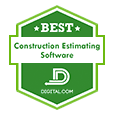The success of any construction project starts with an accurate, organized, and detailed estimate, and when you’re dealing with commercial projects which tend to be more complex and involved than say other types of estimates, the stakes are often higher. There are typically more fees, more permits, more compliance, and more safety considerations that take place.
That’s why it’s crucial that you get the estimate right from the get-go. In this article, we’ll lay out exactly how you should construct a proper estimate for commercial construction projects so that you can know what to expect financially, and ultimately protect your bottom line.
1. Organize Your Estimate
As a contractor planning a commercial construction project, categorizing necessary labor and material costs is crucial for keeping everything organized and within budget, especially considering the complexity, length, and stakes of commercial projects.
No matter what size your estimate is, be sure to organize it properly so that line items can be found easily and nothing gets lost. A great way to stay organized is to use categories and subcategories in your estimate and to include as much detail as possible as you add line items.
Categories
Categories will be the first level of organization. Oftentimes construction estimators will organize their categories by stage, divisions, areas of work, etc. However, it is important to label categories so that they are easy to navigate. Categories may be different for each company, so be sure to label them according to your unique needs.
Subcategories
Within the categories, estimators can also determine subcategories. These further help to identify costs and find specific line items. Subcategories are often identified by additional details for the chosen category. For example, if the category is “Site Work”, you may choose “Excavation” and “Site Clearing” as names for subcategories.
Line Item Details
As you organize the estimate into categories and subcategories, it’s essential to include any additional details that are relevant to the project. Here are some examples of additional details that we recommend you add:
- Classification (Material, Labor, Subcontractor, Equipment, or Other)
- Room (Study, Dining Room, Library, Kitchen, etc.)
- Stage (Design, Site Work, Framing, Closing, etc.)
- Phase (Planning, Development, Revisions, Warranty, etc.)
- Type (Demolition, Electrical, Plumbing, Landscaping, etc.)
2.Determine Which Pricing Model to Use
In construction estimates, there are three main pricing models. These are known as Cost-Plus, Fixed Price, and Unit Price.
There are pros and cons to each, but your project requirements will determine how you build your estimate and your proposal.
Cost-Plus
Cost-plus pricing is a method used in construction projects where the contractor is paid for all construction-related expenses plus an additional fee to ensure a profit. This extra amount is often a percentage of the total costs, but can also be a fixed fee. As material costs continue to fluctuate, cost-plus pricing is growing in popularity.
This method is useful when project costs are hard to predict because it makes sure the contractor gets paid for any unexpected expenses. However, it requires careful tracking of all costs to ensure the owner gets an accurate final price and has financial transparency.
Fixed-Price
Fixed-price pricing in construction means the contractor agrees to complete a project for a set amount of money. This price is decided before the project starts and stays the same, no matter what happens during construction. Oftentimes, contractors that follow a fixed-price model will include allowances for costs that fluctuate often.
This method benefits owners because they know the total cost from the beginning, reducing the risk of unexpected expenses. However, if costs go up or problems arise, the contractor has to cover those costs without charging extra - with the exception of change orders. This makes careful planning and accurate cost estimation in the preconstruction phase even more crucial for the contractor.
Unit-Price
Unit price pricing in construction involves charging a set amount for each unit of work completed. For example, a contractor might charge a specific price per square foot of flooring installed or per cubic yard of concrete poured.
This method is useful for projects where the amount of work can be easily measured and counted. It allows owners to see how much each part of the project will cost and makes it easier to adjust the total price if the project size changes. However, it requires accurate estimates of the required quantities to avoid surprises in the final cost.
3. Calculate Company Overhead
When designing a commercial construction estimate, it's important to include company overhead and margin. These costs are crucial for ensuring you make a profit. Overhead covers your operating costs and other costs that you will need to account for. Understanding and calculating these elements correctly will help you create more accurate and competitive estimates.
Calculating Waste
One of the first things to consider is waste. In construction, waste refers to extra materials that are not used or are damaged during the project. To calculate waste, you need to estimate the percentage of each material that will be wasted. For example, if you’re installing tiles, you might estimate that 10% will be wasted due to cutting and breakage. This percentage is then added to the total amount of material needed. At the end of the project, you can run reports and determine if the waste percentage needs adjusting.
Operating Costs
Operating costs, also known as overhead, are the expenses needed to keep your business running, regardless of the specific project. These can include rent for your office, utilities, salaries for administrative staff, insurance, construction management software, and equipment maintenance. To calculate your operating costs, add up all these expenses for a month or year and divide by the number of projects you typically handle in that time period. This gives you a per-project overhead cost to include in your estimate.
Other Considerations
Besides waste and operating costs, there are other factors to consider when calculating your overhead and margin. These might include unexpected expenses like equipment breakdowns, price increases for materials, or delays due to bad weather, or expected expenses like cleanup costs. It's wise to include a buffer in your estimate to cover these unforeseen costs so that you don’t lose money.
4. Set Profit Expectations
There are many considerations when calculating profits. First, it is important to note the difference between markup and margin. Next, consider the difference between net profits and gross profits. Finally, be sure to carefully calculate your profit with things like competition and experience in mind.
Markup vs. Margin
Markup and margin are two terms that are often confused with one another. Markup is an added percentage or cost for a specific line item in an estimate. Margin, on the other hand, is an overall percentage or fixed cost. For example, a contractor may want to add a 5% markup to the price of subcontractor labor, and also add an overall 5% margin to the entire estimate.
When determining how much markup and margin to add to your estimate, you must consider your level of experience and market competition. It is important to find a balance between over-charging and selling yourself short. Then, through experience, you can determine which profit calculations lead to the most success.
By using a construction software management tool like ConstructionOnline, you can assign markup percentages to classifications in the estimate settings. This way, as the estimator is building an estimate, the markups to classifications will automatically apply and calculate. Per the example, the contractor could set the 5% markup for subcontractor classifications once, and never have to worry about it again.
For more information, check out our Knowledge base article here: Markup vs Margin.
Net vs. Gross Profit
Net profit and gross profit are both important measures of a company's financial health, but they show different things.
Gross profit is the money you make from completing the project after subtracting the cost of producing it, such as materials and labor.
Net profit is what’s left after you subtract all other expenses from the gross profit, such as overhead and subcontractor costs. In short, gross profit shows how much overall money you made at the completion of a project, while net profit shows how much money you actually keep after all expenses are paid.

5. Use Estimate Templates
When working on commercial construction projects, using estimate templates can be the difference between wasting time and money, and estimating more efficiently and accurately. By using an estimate template, you can ensure that you don’t forget any important details and that your estimates are consistent for every project.
If you’re in need of some accurate, easy-to-use, reusable estimate templates for your commercial projects, check out these free estimate template spreadsheets we’ve created using our decades of experience in helping contractors create estimates:
With our free templates, you can adjust its contents and save your updates so that it will be tailored to your company’s needs for future projects. You can create multiple repeatable templates as well, which gives your team a library of estimate templates for a quicker and easier estimate creation process.
6. Track Actual Costs
Tracking actual costs and comparing them to your estimate is a crucial part of any commercial construction project. It helps you stay on budget and make informed decisions as the project progresses.
This practice ensures that you have a clear understanding of where your money is going and allows you to adjust your plans if necessary.
Staying on Budget and Avoiding Surprises
One of the main reasons to track actual costs is to stay on budget and avoid financial disasters. By regularly comparing your expenses to your original estimate, you can quickly spot any areas where you are overspending. This allows you to take action before costs get out of control.
Unexpected expenses, such as delays due to bad weather, changes in material prices, or necessary change orders can arise at any time, but by keeping a close eye on your spending, you can prepare for these surprises and adjust your budget accordingly, reducing the risk of running out of money before the project is finished.
Making Informed Decisions
When you track actual costs, you have the information you need to make informed decisions. If you see that a certain part of the project is costing more than expected, you can decide whether to cut costs in other areas or find additional funding.
This helps you manage your project more effectively and ensures that you can complete it without compromising on quality. Being aware of your financial status at all times allows you to respond swiftly and appropriately to any financial challenges that arise.
Improving Future Estimates
Another benefit of tracking actual costs is that it helps improve your future estimates. By comparing your estimated costs to the actual expenses, you can see where you might have underestimated or overestimated in the past.
This information is valuable for creating more accurate estimates for future projects, making your business more competitive and successful. Learning from past projects helps you refine your estimating process, leading to better planning and budgeting for future jobs.
If you’ve found this guide helpful, you can do all of the suggestions and best practices we’ve given you by using our all-inclusive, accurate construction estimating software called OnCost™ Estimating, which is optimal for creating commercial construction estimates.
You’ll experience increased accuracy in your estimates and time savings so that your business remains successful and profitable with tools like an easy-to-use interface, bi-directional accounting integration, and other financial features that help you track and manage your estimates efficiently.




.png?width=230&name=uda_renew_logo%20(1).png)



